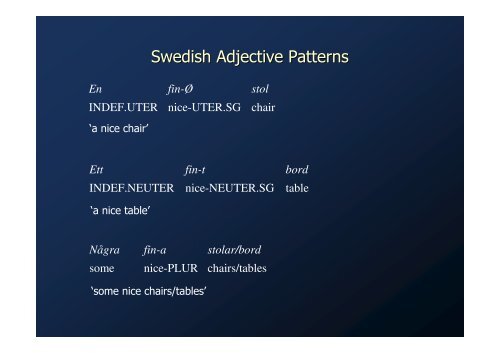Swedish Adjective Patterns
Swedish Adjective Patterns
Swedish Adjective Patterns
You also want an ePaper? Increase the reach of your titles
YUMPU automatically turns print PDFs into web optimized ePapers that Google loves.
<strong>Swedish</strong> <strong>Adjective</strong> <strong>Patterns</strong><br />
En<br />
INDEF.UTER<br />
‘a nice chair’<br />
fin-Ø<br />
nice-UTER.SG<br />
stol<br />
chair<br />
Ett<br />
INDEF.NEUTER<br />
‘a nice table’<br />
fin-t<br />
nice-NEUTER.SG<br />
bord<br />
table<br />
Några<br />
some<br />
fin-a<br />
nice-PLUR<br />
stolar/bord<br />
chairs/tables<br />
‘some nice chairs/tables’
Missing Neuter Forms<br />
(i) Polysyllabic adjectives with a stem ending in a long vowel + d<br />
gravid [gra'vi:d] ‘pregnant’, morbid [m]r'bi:d] ‘morbid’<br />
(ii) Two monosyllabic adjectives with short vowels ending in d<br />
rädd [red] ‘afraid’, fadd [fad] ‘stale’<br />
(iii) Certain monosyllabic adjectives with long vowels ending in t<br />
lat [lY:t] ‘lazy’, flat [flY:t] ‘flat’<br />
(iv) Certain monosyllabic adjectives with long vowels ending in d<br />
pryd [pry:d] ‘prude’, vred [vre:d] ‘wrathful’<br />
(v) Polysyllabic adjectives with final stress ending in a vowel<br />
disträ [dwst<br />
st're:] ‘absent-minded’,<br />
blasé [bla'se:] ‘jaded’
Common <strong>Adjective</strong> Paradigms<br />
d-final stems:<br />
död (‘dead’) [dø:d]<br />
→ [dœt]<br />
glad (‘happy’)<br />
[glY:d<br />
:d] → [glat]<br />
t-final stems:<br />
het (‘hot’)<br />
slät (‘smooth’)<br />
Vowel-final stems<br />
ny (‘new’)<br />
fri (‘free’)<br />
[he:t] → [het]<br />
[sle:t<br />
:t] → [slet]<br />
[ny:] → [nyt]<br />
[fri:] → [frwt]
Two morphophonological ’rules’<br />
Vowel shortening<br />
Affects long final vowels when a -t suffix is added:<br />
[ny:] + [t] = [nyt]<br />
Dental assimilation<br />
Affects dental plosives when a -t suffix is added:<br />
[dø:d] + [t] = [dœt]
Vowel shortening also appears in verb paradigms<br />
ge (’give’):<br />
[je:] → [jet]<br />
(‘have given’)<br />
ro (’row’):<br />
[ru:] → [rt]<br />
(‘have rowed’)<br />
fly (’flee’):<br />
[fly:] → [flyt] (‘have fled’)<br />
stå (’stand’): [sto:] → [st]t]<br />
(‘have stood’)<br />
Not a phonological rule:<br />
get (’goat’) = [je:t]<br />
rot (’root’) = [ru:t]<br />
flyt (’luck’) = [fly:t]<br />
ståt (’pomp’) = [sto:t]
Previous explanations<br />
Derivational Rules (Hellberg 1974)<br />
Semantic Constraints (Pettersson 1990)<br />
Traditional assumptions:<br />
Vowel shortening and dental assimilation apply by default<br />
Defective adjectives are formally different from non-defective ones
Productivity versus Analogy<br />
Productivity<br />
Degrees of Analogy
Selected Definition of Productivity:<br />
A process which creates novel forms that do not<br />
draw any more attention to themselves than<br />
previously encountered forms<br />
Cf. Baayen & Lieber (1991)
Hypothesis:<br />
Neuter gender in <strong>Swedish</strong> is formed by:<br />
[ stem + t ]<br />
This is a productive process within certain constraints:<br />
1. Avoid clusters of dental plosives<br />
2. Avoid long vowels preceding plosive suffixes
Processes to avoid violating constraints:<br />
Dental assimilation<br />
Vowel shortening<br />
I will argue:<br />
Vowel shortening and certain types of dental<br />
assimilation represent unproductive processes for<br />
all adjectives, not only the defective ones.
Are both processes unproductive<br />
fadd (’stale’): [fad] → *[fat]<br />
Shows the unproductive nature of dental assimilation<br />
lat (’lazy’): [lY:t]<br />
→ *[lat]<br />
Shows the unproductive nature of vowel shortening<br />
These facts are supported by a pilot study using<br />
nonce adjectives with relevant phonological forms
Morphotactic Transparency<br />
Hierarchy of Morphotactic Transparency (Dressler 1985)<br />
I: Intrinsic allophonic phonological rules (excite<br />
→ excitement)<br />
II: Phonological rules – resyllabification (exist<br />
→ exis‘tence)<br />
III: Neutralizing phonological rules<br />
([rawd]<br />
→ [raw÷d<br />
w÷d])<br />
IV: Morphophon. rules – velar softening (electric<br />
→ electricity)<br />
V: Morphophon. rules with fusion (conclude<br />
→ conclusion)<br />
VI: Morphophon. rules – vowel shift<br />
VII: Weak suppletion<br />
VIII: Strong suppletion<br />
(decide<br />
→ decision)<br />
(child<br />
→ children)<br />
(is<br />
→ am)
How do learners recognize productivity<br />
Transparent phonological/morphological processes<br />
Large proportion of low-frequency types<br />
(Cf. Plag 1999:38)<br />
Vowel shortening and dental assimilation =<br />
Lack of transparency<br />
Low proportion of low-frequency forms
Adjectival Morpho(phono)logical Processes<br />
1. Add a -t suffix to form the neuter (productive)<br />
2. Assimilate identical plosives (productive)<br />
3. Assimilate same-place unstressed syllable plosives (productive)<br />
4. Assimilate same-place stressed syllable plosives (unproductive)<br />
5. Shorten vowels directly preceding suffixes (unproductive)<br />
6. Use null suffixation (unproductive)<br />
7. Use suppletion, i.e. other types of stem changes (unproductive)<br />
The unproductive processes (4-7) all have inherent restrictions =<br />
The process itself constrains productivity
Constraints blocking productivity<br />
[*SUP]: Avoid strong and weak suppletion<br />
[*CIP]: Avoid clusters of identical plosives (t-t,(<br />
d-d, k-k, g-g, , etc.)<br />
[*IGA]: Avoid incorrect gender association<br />
[*LVS]: Avoid long vowels immediately preceding the suffix<br />
[*VSF]: Avoid vowel shortening immediately preceding the suffix<br />
[*CSP]: Avoid clusters of similar but unidentical plosives (d-t,(<br />
, etc.)<br />
[*ASC]: Avoid assimilation of salient unidentical consonants<br />
[*NSX]: Avoid null suffixation
[*ASC] and Degree of Salience<br />
(i)<br />
(ii)<br />
Avoid assimilation of similar but unidentical consonants in stressed ssed syllables<br />
in monosyllabic words = [*ASC]: [red]<br />
→ [ret]<br />
(‘afraid’)<br />
Avoid assimilation of similar but unidentical consonants in stressed ssed syllables<br />
in polysyllabic words = [*ASC] ():<br />
[kan'dwd]<br />
d] → [kan'dwt]<br />
(nonce adj)<br />
(iii) Avoid assimilation of similar but unidentical consonants in unstressed<br />
syllables in polysyllabic words:<br />
['korkad]<br />
→ ['korkat]<br />
(‘stupid’)<br />
(iv) Avoid assimilation of the short consonant in a stressed syllable coda<br />
cluster:<br />
[trwn:d]<br />
→ [trwn:t]<br />
(‘chubby’)<br />
(v)<br />
Avoid assimilation of identical consonants in stressed syllables in<br />
monosyllabic words:<br />
[trœt] → [trœt] (‘tired’)<br />
(vi) Avoid assimilation of identical consonants in stressed syllables in<br />
polysyllabic words: [bw'g<br />
'g]t] → [bw'g]t]<br />
(‘bigoted’)<br />
(vii) Avoid assimilation of identical consonants in unstressed syllables in<br />
polysyllabic words:<br />
['k]lwt]<br />
→ ['k]lwt]<br />
(nonce adj)
Neuter formation of disträ [dist're:] ‘absent-minded’<br />
Candidates<br />
*SUP<br />
*CIP<br />
*IGA<br />
*LVS<br />
*VSF<br />
*CSP<br />
*ASC<br />
*NSX<br />
0%<br />
[dist'rwt]<br />
t]<br />
!*<br />
16%<br />
[dist're:t]<br />
!*<br />
40%<br />
[dist'ret]<br />
t]<br />
!*<br />
61%<br />
<br />
[dist're:]<br />
*<br />
Neuter formation of lat [lY:t] ‘lazy’<br />
Candidates<br />
*SUP<br />
*CIP<br />
*IGA<br />
*LVS<br />
*VSF<br />
*CSP<br />
*ASC<br />
*NSX<br />
0%<br />
[lY:t<br />
:twt] t]<br />
!*<br />
0%<br />
[lY:tt]<br />
!*<br />
<br />
[lY:t]<br />
!*<br />
8%<br />
[lat]<br />
!*<br />
53%<br />
<br />
[lY:t]<br />
*
Neuter formation of gravid [gra'vi:d] ‘pregnant’<br />
Candidates<br />
*SUP<br />
*CIP<br />
*IGA<br />
*LVS<br />
*VSF<br />
*CSP<br />
*ASC<br />
*NSX<br />
0%<br />
[gra'vwdt]<br />
!*<br />
*<br />
9%<br />
[gra'vi:d]<br />
!*<br />
*<br />
10%<br />
[gra'vi:t]<br />
!*<br />
*<br />
43%<br />
[gra'vwt]<br />
!*<br />
*<br />
71%<br />
<br />
[gra'vi:dt]<br />
*<br />
Neuter formation of rädd [red] ‘afraid’<br />
Candidates<br />
*SUP<br />
*CIP<br />
*IGA<br />
*LVS<br />
*VSF<br />
*CSP<br />
*ASC<br />
*NSX<br />
0%<br />
[redwt]<br />
!*<br />
13%<br />
[red]<br />
!*<br />
*<br />
28%<br />
[redt]<br />
!*<br />
51%<br />
<br />
[ret]<br />
*
Neuter formation of bigott [bw'g<br />
'g]t] ‘bigoted’<br />
Candidates<br />
*SUP<br />
*CIP<br />
*IGA<br />
*LVS<br />
*VSF<br />
*CSP<br />
*ASC<br />
*NSX<br />
0%<br />
[bw'g<br />
'g]twt] t]<br />
!*<br />
0%<br />
[bw'g<br />
'g]tt]<br />
!*<br />
<br />
[bw'g<br />
'g]t]<br />
!*<br />
100%<br />
<br />
[bw'g<br />
'g]t]<br />
Neuter formation of trind [trwn:d] ‘chubby’<br />
Candidates<br />
*SUP<br />
*CIP<br />
*IGA<br />
*LVS<br />
*VSF<br />
*CSP<br />
*ASC<br />
*NSX<br />
0%<br />
[trwn:d<br />
n:dwt]<br />
!*<br />
0%<br />
[trwn:d]<br />
!*<br />
*<br />
0%<br />
[trwn:dt]<br />
!*<br />
100%<br />
<br />
[trwn:t]
New problem:<br />
Neuter forms that violate the constraints exist of<br />
frequent adjectives such as:<br />
död (‘dead’), fri (‘free’) and het (‘hot’)<br />
But no neuter forms exist of similarly frequent<br />
adjectives such as:<br />
rädd (‘afraid’), gravid (‘pregnant’) and lat (‘lazy’)
Frequency distribution<br />
Non-Defective <strong>Adjective</strong>s<br />
Defective <strong>Adjective</strong>s<br />
ny (’new’)<br />
55492<br />
rädd (’afraid’)<br />
8256<br />
död (’dead’)<br />
13108<br />
gravid (’pregnant’)<br />
807<br />
fri (’free’)<br />
10115<br />
lat (’lazy’)<br />
343<br />
glad (’happy’)<br />
9082<br />
kåt (’horny’)<br />
135<br />
blå (’blue’)<br />
7529<br />
paranoid (’paranoid’)<br />
131<br />
röd (’red’)<br />
4523<br />
flat (’flat’)<br />
118<br />
bred (’broad’)<br />
4494<br />
fadd (’stale’)<br />
93<br />
het (’hot’)<br />
2359<br />
rigid (’rigid’)<br />
76<br />
rå (’raw’)<br />
1602<br />
disträ (’absent-minded’)<br />
70<br />
söt (’sweet’)<br />
fet (’fat’)<br />
slät (’smooth’)<br />
våt (’wet’)<br />
solid (’solid’)<br />
spröd (’brittle’)<br />
1261<br />
1053<br />
537<br />
463<br />
279<br />
174<br />
rät (’straight’)<br />
valid (’valid’)<br />
pryd (’prude’)<br />
blasé (’jaded’)<br />
timid (’timid’)<br />
morbid (’morbid’)<br />
68<br />
59<br />
58<br />
58<br />
30<br />
28
The role of Animacy<br />
Most animate nouns in <strong>Swedish</strong> have uter gender<br />
Non-defective adjectives which describe inner states are<br />
rarely used with neuter nouns, for example:<br />
ledsen (‘sad’, uter): 2364 occurrences (99%)<br />
ledset (‘sad’, neuter): 25 occurrences (1%)<br />
Conclusion: Unavailable neuter adjectives have<br />
restricted communicative motivation
For neuter forms affected by the constraints:<br />
Existing neuter forms have been formed either<br />
1. At a time when these processes were productive<br />
2. By analogy because a form was needed<br />
Neuter forms are kept alive by positive evidence<br />
if there is sufficient communicative motivation<br />
However, such forms do not appear automatically when<br />
the uter form of an adjective has been acquired
Explanation of Defective <strong>Adjective</strong>s in <strong>Swedish</strong><br />
1. The occurrence of certain strong constraints, for example:<br />
Avoid clusters of dental plosives<br />
Avoid long vowels preceding dental plosive suffixes<br />
2. Due to lack of morphotactic transparency, the processes<br />
normally used to avoid violating the constraints are<br />
based on analogy rather than productivity.<br />
3. Only neuter forms with sufficient communicative<br />
motivation become established in the language.<br />
4. Defective adjectives are either generally infrequent or<br />
collocate strongly with animate (uter) nouns.




